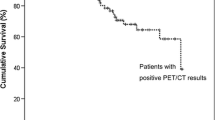Abstract
Purpose
The diagnosis of peritoneal carcinomatosis secondary to ovarian cancer is a real challenge in the cancer imaging field. In this retrospective study, we evaluate the accuracy of Single Detector Computed Tomography (SDCT), Multi Detector Computed Tomography (MDCT), and Positron Emission Tomography–Computed Tomography with F18-fluorodeoxyglucose ([18F]FDG-PET/CT) in the diagnosis of peritoneal seeding and we evaluate the possible applications of MDCT to predict the complete surgical removal of the peritoneal deposits.
Methods and materials
A total of 228 scans (91 SDCT, 89 MDCT, and 48 [18F]FDG-PET/CT) of patients with peritoneal carcinomatosis secondary to ovarian cancer proved at laparoscopy and confirmed by histopathology were retrospectively reviewed by two independent groups of Radiologists and Nuclear Medicine Physicians for the evaluation of ascites, peritoneal nodules, and omental cake signs.
Results
MDCT showed 81% of true positives, SDCT 72.5%, and [18F]FDG-PET/CT 77%. False negatives were 19% for MDCT, 27.5% for SDCT, and 23% for [18F]FDG-PET/CT.
Conclusion
From our results, we concluded that MDCT is the technique of choice in the diagnosis of peritoneal seeding, while [18F]FDG-PET/CT, though showing similar accuracy, remains the most accurate technique for monitoring therapeutic response and disease recurrence. MDCT could play an important role due to its ability to predict the possibility of complete surgical removal of disease thus influencing the treatment plan aimed to improve quality of life.








Similar content being viewed by others
References
American Cancer Society (2009) Cancer Facts and Figs 2009. Atlanta, GA: American Cancer Society
Johns Hopkins ovarian cancer website. http://ovariancancer.jhmi.edu/menu_understanding.cfm. Accessed 11 September 2009
Ozols RF (2005) Treatment goals in ovarian cancer. Int J Gynecol Cancer 5(suppl 1):3–11
Meyers MA (1973) Distribution of intra-abdominal malignant seeding: dependency on dynamics of flow of ascitic fluid. Am J Roentgenol Radium Ther Nucl Med 119:198–206
Schwartz PE (2008) Cytoreductive surgery in the management of ovarian cancer. Oncology (Williston Park) 22(9):1025–1033 (discussion 1033–8, 1041,1045)
Bristow RE, Tomacruz RS, Armstrong DK, et al. (2002) Survival effects of maximal cytoreductive surgery for advanced ovarian carcinoma during the platinum era: a meta analysis. J Clin Oncol 20:1248–1259
Van der Burg ME (2001) Advanced ovarian cancer. Curr Treat Options Oncol 2:109–118
Kurtz AB, Tsimikas JV, Tempany CM, et al. (1999) Diagnosis and staging of ovarian cancer: comparative values of Doppler and conventional US, CT, and MR imaging correlated with surgery and histopathologic analysis—Report of the Radiology Diagnostic Oncology Group. Radiology 212:19–27
Nelson BE, Rosenfield AT, Schwartz PE (1993) Preoperative abdominopelvic computed tomographic prediction of optimal cytoreduction in epithelial ovarian carcinoma. J Clin Oncol 11(1):166–172
William MR. Introduction to gynaecologic oncology. www.gyncancer.com/ovarian-cancer.html. Accessed 11 September 2009
Edmonson JH, McCormack GW, Fleming TR, et al. (1985) Comparison of cyclophosphamide plus cisplatin versus hexamethylmelamine, cyclophosphamide, doxorubicin, and cisplatin in combination as initial chemotherapy for stage III and IV ovarian carcinomas. Cancer Treat Rep 69:1243–1248
Omura GA, Brady MF, Homesley HD, et al. (1991) Long follow-up and prognostic factor analysis in advanced ovarian carcinoma: the Gynecologic Oncology Group experience. J Clin Oncol 9:1138–1150
Griffiths C (1975) Surgical resection of tumor bulk in the primary treatment of ovarian carcinoma. Natl Cancer Inst Monogr 42:101–104
Boente MP, Chi DS, Hoskins WJ (1998) The role of surgery in the management of ovarian cancer: primary and interval cytoreductive surgery. Semin Oncol 25:326–334
Prokopf M, Galanski M (2003) Peritoneal Carcinomatosis and Metastases. Spiral and Multislice Computed Tomography of the Body, vol 16, pp 609–610
Forstner R (2007) Radiological staging of ovarian cancer: imaging findings and contribution of CT and MRI. Eur Radiol 17(12):3223–3235 (Epub 2007 Aug)
Delbeke D, Martin WH (2001) Positron emission tomography imaging in oncology. Radiol Clin North Am 39(5):883–917
Hamacher K, Coenen HH, Stocklin G (1988) Efficient stereospecific synthesis of no-carried-added 2-[18F]-fluoro-2-d-glucose using aminopolyether supported nucleophilic substitution. J Nucl Med 29:241–247
Holschneider CH, Berek JS (2000) Ovarian cancer: epidemiology, biology, and prognostic factors. Semin Surg Oncol 19:3–10
Wimberger P, Lehmann N, Kimmig R, et al. (2007) Arbeitsgemeinschaft Gynaekologische Onkologie Ovarian Cancer Study Group Prognostic factors for complete debulking in advanced ovarian cancer and its impact on survival. An exploratory analysis of a prospectively randomized phase III study of the Arbeitsgemeinschaft Gynaekologische Onkologie Ovarian Cancer Study Group (AGO-OVAR). Gynecol Oncol 106(1):69–74
Turlakow A, Yeung HW, Salmon AS, Macapinlac HA, Larson SM (2003) Peritoneal carcinomatosis: role of (18)F-FDG PET. J Nucl Med 44(9):1407–1412
Dromain C, Leboulleux S, Auperin A, et al. (2008) Staging of peritoneal carcinomatosis: enhanced CT vs. PET/CT. Abdom Imaging 33:87–93
Tempany CM, Zou KH, Silverman SG, et al. (2000) Staging of advanced ovarian cancer: comparison of imaging modalities—report from the Radiology Oncology Group. Radiology 215:761–767
Coakley FV, Choi PH, Cougoutas CA, et al. (2002) Peritoneal metastases: detection with spiral CT in patients with ovarian cancer. Radiology 223:495–499
Low RN, Chen SC, Barone R (2003) Distinguishing benign from malignant bowel obstruction in patients with malignancy: findings at MR imaging. Radiology 228(1):157–165
Fujii S, Matsusue E, Kanasaki Y, et al. (2008) Detection of peritoneal dissemination in gynecological malignancy: evaluation by diffusion-weighted MR imaging. Eur Radiol 18(1):18–23 (Epub 2007 Aug 14)
Pannu HK, Bristow RE, Cohade C, Fishman EK, Wahl RL (2004) PET-CT in recurrent ovarian cancer: initial observations. Radiographics 24(1):209–223
Gadducci A, Cosio S (2009) Surveillance of patients after initial treatment of ovarian cancer. Crit Rev Oncol Hematol [Epub ahead of print]
Nakamoto Y, Saga T, Ishimori T, et al. (2001) Clinical value of positron emission tomography with FDG for recurrent ovarian cancer. Am J Roentgenol 176:1449–1454
Author information
Authors and Affiliations
Corresponding author
Rights and permissions
About this article
Cite this article
Funicelli, L., Travaini, L.L., Landoni, F. et al. Peritoneal carcinomatosis from ovarian cancer: the role of CT and [18F]FDG-PET/CT. Abdom Imaging 35, 701–707 (2010). https://doi.org/10.1007/s00261-009-9578-8
Published:
Issue Date:
DOI: https://doi.org/10.1007/s00261-009-9578-8




